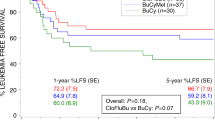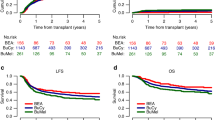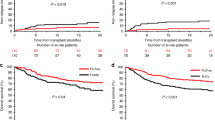Summary:
There is growing interest in autologous stem cell transplantation (ASCT) for elderly patients with acute myeloid leukemia (AML). While mortality and toxicity from ASCT have been reduced, relapse rate is still high. In a prospective study, we investigated the feasibility of a new conditioning regimen consisting of high-dose idarubicin plus busulfan in AML patients aged over 60 years undergoing ASCT. A total of 14 patients (median age: 64 years) received 2 days continuous infusion of idarubicin at 20 mg/m2/day, followed by 3 days of oral busulfan (4 mg/kg/day) as conditioning. No case of transplant-related mortality occurred. The median number of days to neutrophil (>0.5 × 109/l) and platelet (>20 × 109/l) recovery was 11 and 12, respectively. Cardiac toxicity was absent, while 12 patients (86%) had grade 3–4 mucositis. After a median follow-up of 9 months from ASCT, nine of 14 patients are alive in continuous complete remission (CR), four have relapsed at 3, 6, 8 and 9 months, and one died in CR1 from gastric cancer. Our data demonstrate the feasibility of a conditioning regimen based on high-dose idarubicin plus busulfan in elderly AML patients. Results concerning reduction of relapse rate need confirmation in a larger series with longer follow-up.
This is a preview of subscription content, access via your institution
Access options
Subscribe to this journal
Receive 12 print issues and online access
$259.00 per year
only $21.58 per issue
Buy this article
- Purchase on Springer Link
- Instant access to full article PDF
Prices may be subject to local taxes which are calculated during checkout

Similar content being viewed by others
References
Pinto A, Zagonel V, Ferrara F . Acute myeloid leukaemia in the elderly. Biology and therapeutic strategies. Crit Rev Oncol Hematol 2001; 39: 275–287.
Ferrara F, Mirto S, Zagonel V, Pinto A . Acute myeloid leukemia in the elderly: a critical review of therapeutic approaches and appraisal of results of therapy. Leuk Lymphoma 1998; 29: 375–382.
Wahlin A, Markevarn B, Golovleva I et al. Prognostic significance of risk group stratification in elderly patients with acute myeloid leukaemia. Br J Haematol 2001; 115: 25–33.
Leith CP, Kopecky KJ, Godwin J et al. Acute myeloid leukemia in the elderly: assessment of multidrug resistance (MDR1) and cytogenetics distinguishes biologic subgroups with remarkably distinct responses to standard chemotherapy. A Southwest Oncology Group study. Blood 1997; 89: 3323–3329.
Sekeres MA, Stone RM . The challenge of acute myeloid leukemia in older patients. Curr Opin Oncol 2002; 14: 24–30.
Gorin NC, Labopin M, Pichard P et al. Feasibility and recent improvement of autologous stem cell transplantation for acute myelocytic leukaemia in patients over 60 years of age: importance of the source of stem cells. Br J Haematol 2000; 110: 887–893.
Ferrara F, Venditti A, Carella Jr AM et al. Autologous stem-cell transplantation for patients with acute myeloid leukaemia aged over 60 years. Eur J Haematol 2002; 69: 200–204.
Santos GW, Tutschka PJ, Brookmeyer R et al. Marrow transplantation for acute non lymphocytic leukemia after treatment with busulfan and cyclophosphamide. N Engl J Med 1983; 309: 1347–1353.
Tutschka PJ, Copelan EA, Klein JP . Bone marrow transplantation for leukemia following a new busulfan and cyclophosphamide regimen. Blood 1983; 70: 1382–1388.
Meloni G, Vignetti M, Avvisati G et al. BAVC regimen and autograft for acute myelogenous leukemia in second complete remission. Bone Marrow Transplant 1996; 18: 693–698.
Linker CA, Ries CA, Damon LE et al. Autologous bone marrow transplantation for acute myeloid leukemia using 4-hydroperoxycyclophosphamide purged bone marrow and the busulfan-etoposide preparative regimen: a follow-up report. Bone Marrow Transplant 1998; 22: 865–872.
Ferrara F, Annunziata M, Schiavone EM et al. High dose idarubicin as conditioning for autologous stem cell transplantation in acute myeloid leukemia: a feasibility study. Hematol J 2001; 4: 214–219.
Fouillard L, Labopin M, Meloni G et al. Comparison of BAVC and BuCy regimens in autologous stem cell transplantation for adult patients with acute myeloid leukemia. Haematologica 2004; 89: 107–108.
Bennett JM, Catovski D, Daniel MT et al. Proposed revised criteria for the classification of acute myeloid leukemia. Ann Intern Med 1985; 105: 620–625.
Ferrara F, Morabito F, Martino B et al. CD56 expression is an indicator of poor clinical outcome in patients with acute promyelocytic leukemia treated with simultaneous all-trans-retinoic acid and chemotherapy. J Clin Oncol 2000; 18: 1295–1300.
ISCN. In: Mitelman F (ed.) Guidelines for Cancer Cytogenetics, Supplement to an International System for Human Cytogenetic Nomenclature. 1995.
Ferrara F, Mele G, Califano C et al. Fludarabine and cytarabine as continuous sequential infusion for elderly patients with acute myeloid leukemia. Blood 2002; 100: 344a (abstract).
Ferrara F, Palmieri S, Pocali B et al. De novo acute myeloid leukemia with multilineage dysplasia: treatment results and prognostic evaluation from a series of 45 patients treated with fludarabine, cytarabine and G-CSF (FLAG). Eur J Haematol 2002; 68: 203–209.
Avvisati G, Lo Coco F, Diverio D et al. AIDA (all-trans-retinoic-acid + idarubicin) in newly diagnosed acute promyelocytic leukemia: a Gruppo Italiano Malattie Ematologiche Maligne dell'Adulto (GIMEMA) pilot study. Blood 1996; 88: 1390–1398.
Mandelli F, Diverio D, Avvisati G et al. Molecular remission in PML/RAR alpha-positive acute promyelocytic leukemia by combined all-trans retinoic acid and idarubicin (AIDA) therapy. Gruppo Italiano-Malattie Ematologiche Maligne dell'Adulto and Associazione Italiana di Ematologia ed Oncologia Pediatrica Cooperative Groups. Blood 1997; 90: 1014–1021.
WHO Handbook for Reporting Results of Cancer Treatment. Vol. 38 World Health Organization: Geneva, 1979.
Kaplan EL, Meier P . Non-parametric estimation from incomplete observations. J Am Stat Assoc 1958; 53: 457–481.
Gorin NC . Autologous stem cell transplantation for adult acute leukemia. Curr Opin Oncol 2002; 14: 152–159.
Stein AS, O'Donnell MR, Slovak ML et al. Interleukin-2 after autologous stem-cell transplantation for adult patients with acute myeloid leukemia in first complete remission. J Clin Oncol 2003; 21: 615–623.
Linker CA . Autologous stem cell transplantation for acute myeloid leukemia. Bone Marrow Transplant 2003; 31: 731–738.
Taussig DC, Davies AJ, Cavenagh JD et al. Durable remissions of myelodysplastic syndrome and acute myeloid leukemia after reduced-intensity allografting. J Clin Oncol 2003; 15: 3060–3065.
Lawson SE, Williams MD, Darbyshire PJ . Use of idarubicin in pre-transplant conditioning in children with high-risk acute leukaemia. Bone Marrow Transplant 1999; 24: 953–958.
Schaap N, Schattemberg A, Bar B et al. Outcome of transplantation for standard-risk leukaemia with graft depleted of lymphocytes after conditioning with an intensified regimen. Br J Haematol 1997; 98: 750–759.
Mengarelli A, Iori AP, Guglielmi C et al. Idarubicin intensified BUCY2 regimen in allogeneic unmanipulated transplant for high-risk hematological malignancies. Leukemia 2000; 14: 2052–2058.
Jerjis Sh, Roovers E, Muus P et al. Idarubicin to intensify the conditioning regimens of autologous bone marrow transplantation for patients with acute myeloid leukemia in first complete remission. Bone Marrow Transplant 1998; 22: 13–19.
Montillo M, Tedeschi A, Pagano L et al. Feasibility of peripheral blood stem cell rescue as intensification in elderly patients with acute myelocytic leukaemia: a pilot study from the Gimema Group. Br J Haematol 2000; 111: 334–337.
Robak T . Purine nucleoside analogues in the treatment of myeloid leukemias. Leuk Lymphoma 2003; 44: 391–409.
Montillo M, Tedeschi A, Rossi V et al. Successful CD34+ cell mobilization by intermediate-dose Ara-C in chronic lymphocytic leukemia patients treated with sequential fludarabine and Campath-1H. Leukemia 2004; 18: 57–62.
Author information
Authors and Affiliations
Corresponding author
Rights and permissions
About this article
Cite this article
Ferrara, F., Palmieri, S., Annunziata, M. et al. Continuous infusion idarubicin and oral busulfan as conditioning for patients with acute myeloid leukemia aged over 60 years undergoing autologous stem cell transplantation. Bone Marrow Transplant 34, 573–576 (2004). https://doi.org/10.1038/sj.bmt.1704611
Received:
Accepted:
Published:
Issue Date:
DOI: https://doi.org/10.1038/sj.bmt.1704611
Keywords
This article is cited by
-
High-dose idarubicin plus busulfan as conditioning regimen to autologous stem cell transplantation: Promising post-remission therapy for acute myeloid leukemia in first complete remission?
Medical Oncology (2014)
-
Long-term results of a prospective randomized trial evaluating G-CSF priming in intensive induction chemotherapy followed by autologous stem cell transplantation in elderly patients with acute myeloid leukemia
Annals of Hematology (2014)
-
Idarubicin-intensified BUCY2 regimens may lower relapse rate and improve survival in patients undergoing allo-SCT for high-risk hematological malignancies: a retrospective analysis
Bone Marrow Transplantation (2012)



